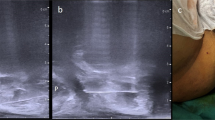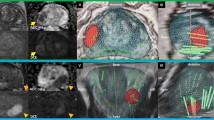Abstract
Background:
To compare prostate cancer detection rates between transrectal ultrasound (TRUS) prostate biopsy and transperineal template prostate biopsy (TPTPB) in biopsy naïve men. TRUS biopsy is still regarded as gold standard for prostate cancer diagnosis. TPTPB has been shown to improve prostate cancer detection in men with rising PSA and previous negative TRUS biopsies. We carried out a prospective study performing both biopsies in the same group of men with a benign feeling digital rectal examination (DRE), PSA <20 ng ml−1 and no previous prostate biopsies.
Methods:
A total of 50 patients with mean age of 67 years (range: 54–84), mean prostate volume 58 cc (range: 19–165) and mean PSA 8 ng l−1 (range: 4–18) underwent standard 12-core TRUS biopsy followed immediately by 36-core TPTPB under general anaesthetic. We determined the prostate cancer detection rate between the two diagnostic modalities.
Results:
In total, 20/50 (40%) had benign pathology. Of 30/50 (60%) diagnosed with prostate cancer, 16 (32%) had positive results in both TRUS and TPTPB, whereas 14 (28%) had negative TRUS but positive TPTPB. No cancers were detected solely by TRUS biopsy. TRUS biopsy detected cancer in 32% versus 60% with TPTPB. In total, 19/30(63%) cancers detected by TPTPB had Gleason score ⩾7. 2 (4%) experienced urosepsis, 7 (14%) temporary urinary retention, 16 (32%) mild haematuria and 19 (38%) haematospermia.
Conclusions:
TPTPB is associated with significantly higher prostate cancer detection rate than TRUS biopsies in biopsy naïve men with a benign feeling DRE and PSA <20 ng ml−1. PSA appears to be better biomarker than previously thought.
This is a preview of subscription content, access via your institution
Access options
Subscribe to this journal
Receive 4 print issues and online access
$259.00 per year
only $64.75 per issue
Buy this article
- Purchase on Springer Link
- Instant access to full article PDF
Prices may be subject to local taxes which are calculated during checkout
Similar content being viewed by others
References
Stamey TA, Yang N, Hay AR, McNeal JE, Freiha FS, Redwine E . Prostate-specific antigen as a serum marker for adenocarcinoma of the prostate. N Engl J Med 1987; 317: 909–916.
Welch HG, Fisher ES, Gottlieb DJ, Barry MJ . Detection of prostate cancer via biopsy in the Medicare-SEER population during the PSA era. J Natl Cancer Inst 2007; 99: 1395–1400.
Stamey TA . Making the most out of six systematic sextant biopsies. Urology 1995; 45: 2–12.
Presti JC, Chang JJ, Bhargava V, Shinohara K . The optimal systematic prostate biopsy scheme should include 8 rather than 6 biopsies: results of a prospective clinical trial. J Urol 2000; 163: 163–166.
Dimmen M, Vlatkovic L, Hole KH, Nesland JM, Brennhovd B, Axcrona K . Transperineal prostate biopsy detects significant cancer in patients with elevated prostate-specific antigen (PSA) levels and previous negative transrectal biopsies. BJU int 2012; 110: E69–E75.
Takeshita H, Numao N, Kijima T, Yokoyama M, Ishioka J, Matsuoka Y et al. Diagnostic performance of initial transperineal 14-core prostate biopsy to detect significant cancer. Int Urol Nephrol 2013; 45: 645–652.
Emiliozzi P, Longhi S, Scarpone P, Pansadoro A, DePaula F, Pansadoro V . The value of a single biopsy with 12 transperineal cores for detecting prostate cancer in patients with elevated prostate specific antigen. J Urol 2001; 166: 845–850.
Djavan B, Ravery V, Zlotta A, Dobronski P, Dobrovits M, Fakhari M et al. Prospective evaluation of prostate cancer detected on biopsies 1, 2, 3 and 4: when should we stop? J Urol 2001; 166: 1679–1683.
Pal RP, Elmussareh M, Chanawani M, Khan MA . The role of a standardized 36 core template-assisted transperineal prostate biopsy technique in patients with previously negative transrectal ultrasonography-guided prostate biopsies. BJU int 2012; 109: 367–371.
Chanawani M, Elmussareh M, Khan MA . Transperineal Template Biopsy: Technique and Role in the Diagnosis of Prostate Cancer. 2011; 1–10. at <http://www.bjui.org/BJUI_IMAGES/SurgicalAtlas/766transperineal%20template%20biopsyfor%20PDF.pdf>.
Mabjeesh NJ, Lidawi G, Chen J, German L, Matzkin H . High detection rate of significant prostate tumours in anterior zones using transperineal ultrasound-guided template saturation biopsy. BJU int 2012; 110: 993–997.
Nafie S, Pal RP, Dormer JP, Khan MA . Transperineal template prostate biopsies in men with raised PSA despite two previous sets of negative TRUS-guided prostate biopsies. World Journal of Urology 2013, 1–5 doi:10.1007/s00345-013-1225-xe-pub ahead of print.
Emiliozzi P, Corsetti A, Tassi B, Federico G, Martini M, Pansadoro V . Best approach for prostate cancer detection: a prospective study on transperineal versus transrectal six-core prostate biopsy. Urology 2003; 61: 961–966.
Kawakami S, Yamamoto S, Numao N, Ishikawa Y, Kihara K, Fukui I . Direct comparison between transrectal and transperineal extended prostate biopsy for the detection of cancer. Int J Urol 2007; 14: 719–724.
Pinkstaff DM, Igel TC, Petrou SP, Broderick GA, Wehle MJ, Young PR . Systematic transperineal ultrasound-guided template biopsy of the prostate: three-year experience. Urology 2005; 65: 735–739.
Bott SRJ, Henderson A, Halls JE, Montgomery BSI, Laing R . Langley SEM. Extensive transperineal template biopsies of prostate: modified technique and results. Urology 2006; 68: 1037–1041.
Shen P-F, Zhu Y-C, Wei W-R, Li Y-Z, Yang J, Li Y-T et al. The results of transperineal versus transrectal prostate biopsy: a systematic review and meta-analysis. Asian J Androl 2011; 14: 310–315.
Galfano A, Novara G, Iafrate M, Cosentino M, Cavalleri S, Artibani W et al. Prostate biopsy: the transperineal approach. EAU-EBU Update Series 2007; 5: 241–249.
Kubo Y, Kawakami S, Numao N, Takazawa R, Fujii Y, Masuda H et al. Simple and effective local anesthesia for transperineal extended prostate biopsy: application to three-dimensional 26-core biopsy. Int Journal Urol 2009; 16: 420–423.
Iremashvili VV, Chepurov AK, Kobaladze KM, Gamidov SI . Periprostatic local anesthesia with pudendal block for transperineal ultrasound-guided prostate biopsy: a randomized trial. Urology 2010; 75: 1023–1027.
Loeb S, Carter HB, Berndt SI, Ricker W, Schaeffer EM . Complications after prostate biopsy: data from SEER-Medicare. J Urol 2011; 186: 1830–1834.
Willis S, Bott S, Montgomery B . Urinary retention following transperineal template prostate biopsy - study of risk factors. J Clin Urol 2013; 6: 55–58.
Author information
Authors and Affiliations
Corresponding author
Ethics declarations
Competing interests
The authors declare no conflict of interest.
Rights and permissions
About this article
Cite this article
Nafie, S., Mellon, J., Dormer, J. et al. The role of transperineal template prostate biopsies in prostate cancer diagnosis in biopsy naïve men with PSA less than 20 ng ml−1. Prostate Cancer Prostatic Dis 17, 170–173 (2014). https://doi.org/10.1038/pcan.2014.4
Received:
Revised:
Accepted:
Published:
Issue Date:
DOI: https://doi.org/10.1038/pcan.2014.4
Keywords
This article is cited by
-
Die transperineale Prostatabiopsie in Lokalanästhesie
Journal für Urologie und Urogynäkologie/Schweiz (2018)
-
Die transperineale Prostatabiopsie in Lokalanästhesie
Journal für Urologie und Urogynäkologie/Österreich (2018)
-
Population-based study of grade progression in patients who harboured Gleason 3 + 3
World Journal of Urology (2017)



